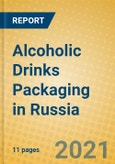The COVID-19 pandemic had a major impact on sales of alcoholic drinks packaging in Russia in 2020, with a very steep decline seen in on-trade sales due to the government-mandated closure of all bars, pubs, clubs, cafés and restaurants throughout the country for extended periods. Even once on-trade outlets were allowed to reopen, many consumers remained reluctant to socialise outside of the home due to the threat of contagion.
The publisher's Alcoholic Drinks Packaging in Russia report offers insight into key trends and developments driving packaging across the category. The report also examines trends and prospect for various pack types and closures: metal packaging, rigid plastic, glass, liquid cartons, paper-based containers; flexible packaging.
Product coverage: Beer, Cider/Perry, RTDs, Spirits, Wine.
Data coverage: market sizes (historic and forecasts), company shares, brand shares and distribution data.
The publisher's Alcoholic Drinks Packaging in Russia report offers insight into key trends and developments driving packaging across the category. The report also examines trends and prospect for various pack types and closures: metal packaging, rigid plastic, glass, liquid cartons, paper-based containers; flexible packaging.
Product coverage: Beer, Cider/Perry, RTDs, Spirits, Wine.
Data coverage: market sizes (historic and forecasts), company shares, brand shares and distribution data.
Why buy this report?
- Get a detailed picture of the Alcoholic Drinks Packaging market;
- Pinpoint growth sectors and identify factors driving change;
- Understand the competitive environment, the market’s major players and leading brands;
- Use five-year forecasts to assess how the market is predicted to develop.
Table of Contents
KEY DATA FINDINGS2020 IMPACT
- On-trade sales slump due to the closure of this channel’s outlets
- Metal beverage cans continue gaining popularity in low-alcohol drinks
- Changes in state packaging standards regulate spirits in small packaging
RECOVERY AND OPPORTUNITIES
- On-trade to see strong growth from 2021 after its steep decline in 2020
- Consumers expected to drink less but favour better-quality products








